Japanese fried fish cakes are made in a similar way to Thai fish cakes but the flavourings are less spicy and use common Japanese seasonings. Unlike typical Western-style fish cakes, they do not use flour or mashed potatoes to bind the fish together. They are mostly fish with finely chopped vegetables mixed in.
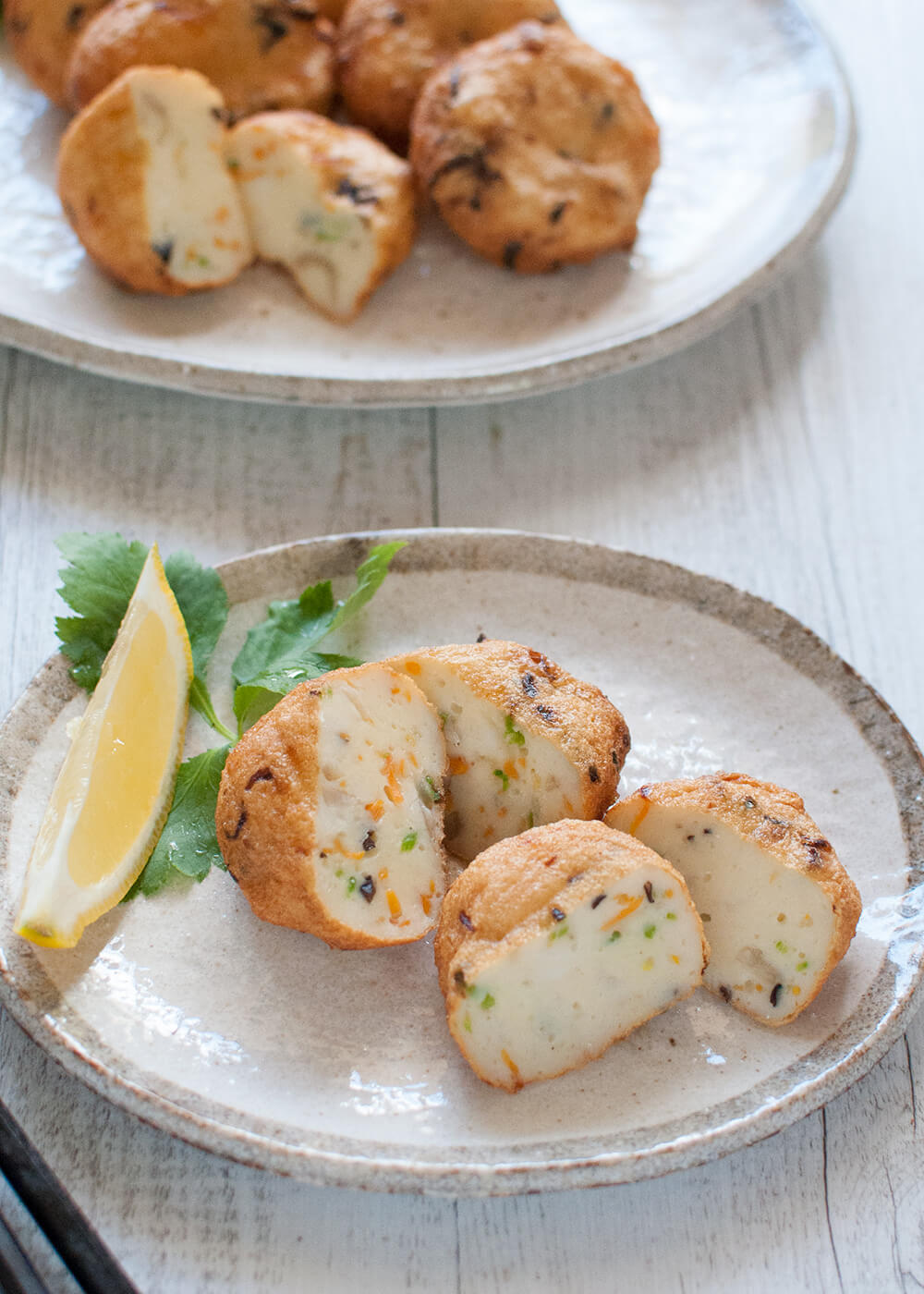
Japanese style fried fish cakes are called ‘satusma-age’ (薩摩揚げ) in the Kanto (Eastern) region of Japan. It is said that the dish came from China via Kagoshima prefecture, which used to be called ‘satsuma’ (薩摩). The word ‘age’ (揚げ) means deep frying. In Kagoshima prefecture, this is called ‘tsukuage’ (つくあげ) and in the Kansai (Western) region, it is called ‘tempura’ (天ぷら). Very confusing…
The ingredients are mainly fish paste with a small amount of finely chopped vegetables, seasoning and egg/corn flour (corn starch) to bind the meat. In some cases, not even vegetables are included.
The vegetables mixed into the fish paste can vary and you can use whatever you have in the fridge and freezer. I had carrot and snow peas in the fridge and burdock in the freezer. Also, I used dried black fungus, which is always in my pantry.
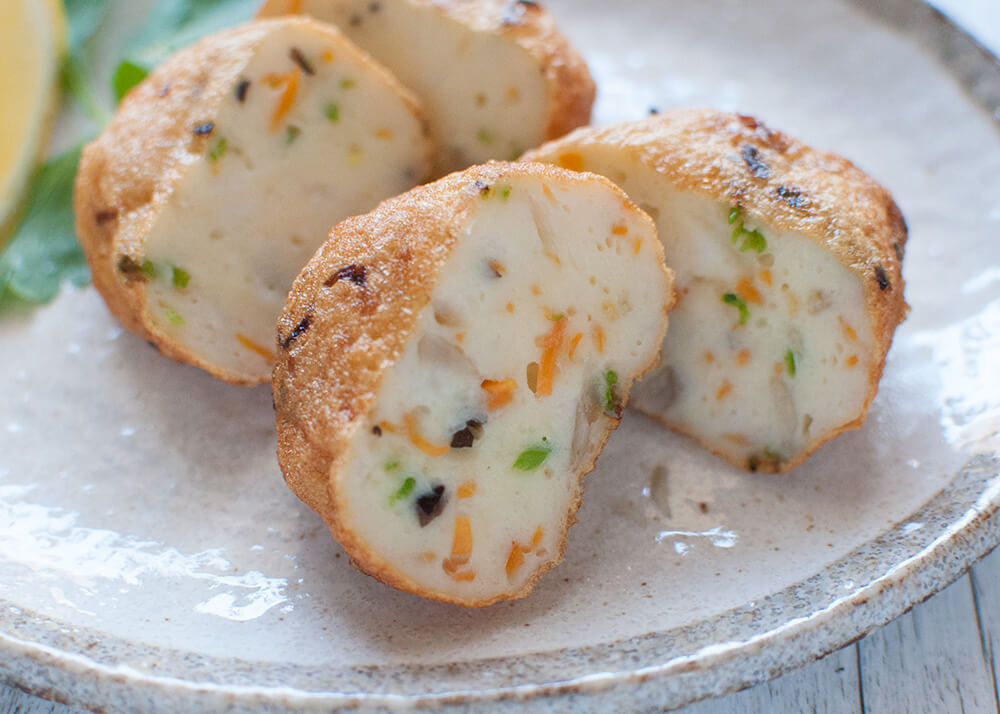
Instead of these vegetables, you can use peas, green beans, shiitake mushrooms (fresh or dried), shallots (scallions) and/or lotus roots, etc. They all need to be chopped thin and small.
I used white-fleshed fish to make fish paste but in Japan, varieties of cheap fish fillets are used to make fish cakes, e.g. sardines, shark, yellow tail (horse mackerel), mackerel. Sometimes, different kinds of fish fillets are mixed together. But I prefer using white fish fillets as the fish with darker flesh are usually fishier and the colour of the fish cakes is not as white as those made of white fish fillets.
Even if egg is added to the fish paste, you will find that the fish paste is quite thick and easy to form a shape. You can see the consistency of the fish paste after adding an egg in the bottom left photo below.
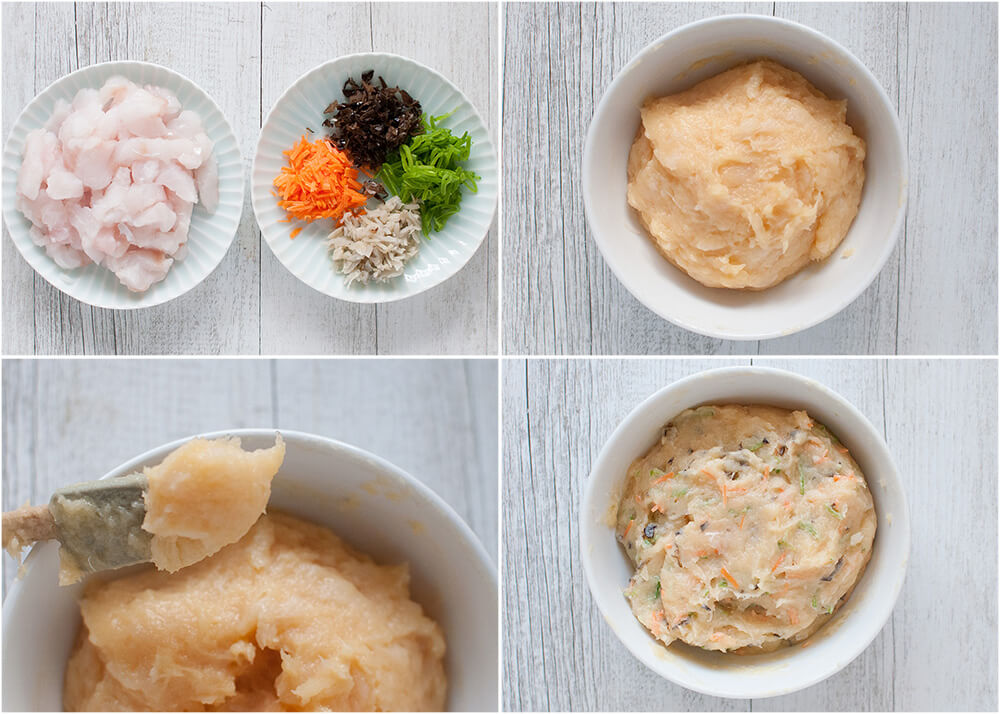
In today’s recipe, I made fish cakes in a flat oval shape but you can make different shapes if you like.
About satsuma-age
Satusma-age is actually a generic name for deep fried fish cakes. Depending on the shape of satsuma-age and the vegetables added to it, they are named differently. The following are some of the popular satsuma-age.
- Hira-ten (ひら天)– flat oval shape
- Bōru-ten (ボール天) – ball shape
- Kaku-ten (角天) – flat rectangle shape
- Gobō-ten or gobō-maki (ごぼう天 or ごぼう巻き) – log shape with a burdock stick in the centre
- Ika-ten or ika-maki (イカ天 or イカ巻き) – log shape with squid piece in the centre
- Yasai-ten (野菜天) – Flat round, oval or rectangle shape with mixed vegetables
So, satsuma-age in today’s recipe is yasai-ten. You will find photos of some of the above in my post Oden as satsuma-age is one of the main ingredients of oden.
Similar to satsuma-age is ’chikuwa’ (ちくわ or 竹輪), which I used in Oden, Chawanmushi and Curry Udon. It is also a fish cake but instead of deep frying the fish cake, it is steamed and then grilled.
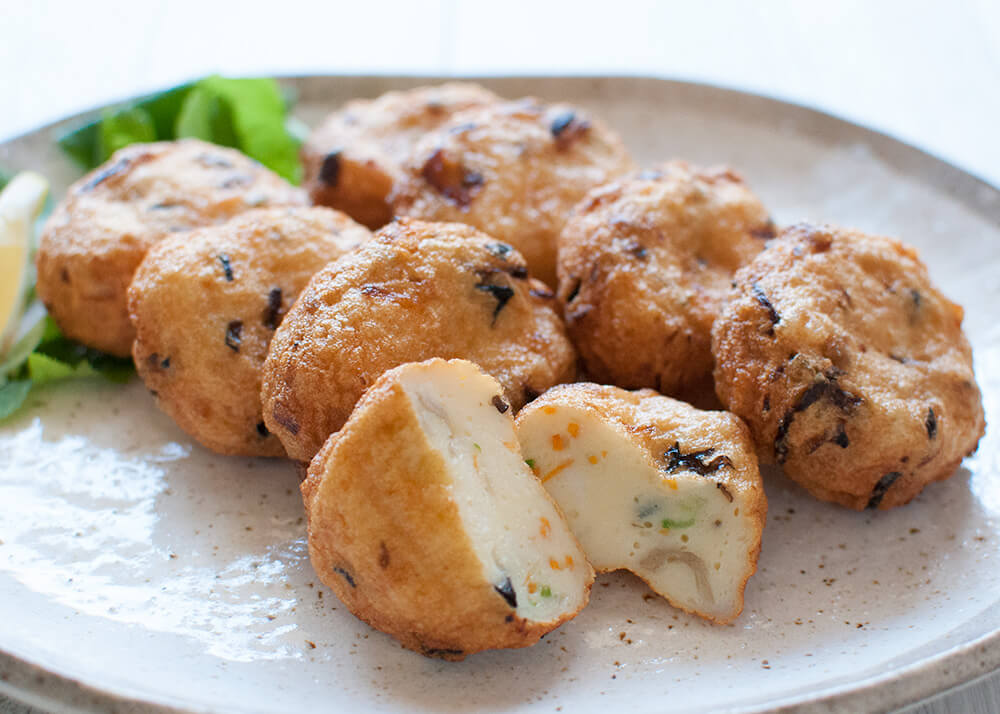
If you have a food processor, making satsuma-age is quite easy. Make the fish paste in the food processor, mix in other ingredients, shape fish cakes, then deep fry. Serve with grated ginger and soy sauce, or lemon wedges.
Each fish cake is just the right size to pick up and bite into. Freshly made hot satsuma-age is so good that I usually pick it up as soon as it is fried and have a big bite. So I often end up not having enough fish cakes left to serve!
You can freeze satsuma-age. I sometimes grill satsuma-age, especially when they are stored in the fridge or frozen. They are equally tasty.
Yumiko
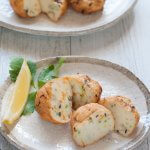
Japanese fried fish cakes are made in a similar way to Thai fish cakes but the flavourings are less spicy and use common Japanese seasonings. Unlike typical Western-style fish cakes, they do not use flour or mashed potatoes to bind the fish together. It is mostly fish with finely chopped vegetables mixed in.
- 300 g (0.7lb) white fish fillet , boneless & skinless (note 1)
- 2 tsp sake
- 1 tsp ginger juice from grated ginger
- 1 tsp salt
- 1.5 tsp sugar
- 1 egg
- oil for deep frying
- 10 g (0.4oz) carrots , julienned into 1cm long very fine sticks
- 10 g (0.4oz) snow peas , julienned crosswise finely
- 10 g (0.4oz) burdock , julienned into 1cm long very fine sticks (note 3)
- 10 g (0.4oz) black fungus , rehydrated and finely chopped
- 1 tbsp corn flour (corn starch)
- Lemon wedges or grated ginger with soy sauce
-
Cut fish fillet into small pieces so that it is easier to make paste in a food processor.
-
Add fish pieces, sake, ginger juice, salt and sugar to a food processor and whizz until the mixture becomes paste.
-
Add egg to the fish paste and blend well.
-
Add all the Vegetable mixture in a large bowl and mix well ensuring that vegetable pieces are evenly coated with corn flour. This will allow the vegetables to stick to the paste better.
-
Add the fish paste to the bowl and mix well. Divide the mixture into 10 equal portions.
-
Heat oil in a deep frypan or a skillet to 170C (335F) (note 4).
-
Wet your hands. Take 1/10 of the fish cake mixture and make a ball, then flatten to make flat oval shape (note 5). Place it in the oil.
-
Fry for 2-2.5 minutes until bottom side of the fish cake is golden brown. Turn it over to cook for further 2-2.5 minutes until golden brown.
-
Remove the fish cake and drain oil on a rack or kitchen paper.
-
Repeat steps 7, 8, 9 for the rest of the fish cakes (note 6).
-
Serve while hot or at room temperature with lemon wedges, or grated ginger with soy sauce (note 7) if using.
1. I used ocean perch fillets but you could use any white meat fillets. In Japan, cod is often used to make fish cakes at home. It does not have to be white meat, you could use fish such as sardines, yellow tail (horse mackerel), or mackerel but white meat fish would be less fishy when cooked. Avoid very oily fish.
2. I used these vegetable as I already had them. You can use other vegetables such as finely chopped onion, green peas, beans, shiitake mushrooms, or lotus roots. It is important to chop the vegetables very small.
3. I used frozen shredded burdock as fresh burdock roots are not readily available in Sydney. Frozen burdock can be purchased in Japanese/Asian grocery stores.
4. To check the temperature of the oil without a thermometer, use one of the following.
a. Drop small bits of breadcrumbs into the oil. The bits will sink half way and then come up with small bubbles around them.
b. Stick a pair of bamboo chopsticks into the oil. Small bubbles appear around the chopsticks and come up constantly.
5. I made oval shaped fish cakes because they are common in Japan. But they can be round, square, smaller balls or log shape if you like. If making balls, you need to divide the fish paste mixture into smaller quantities, making more pieces.
6. You can fry many fish cakes at once as long as you don’t over-crowd the oil with too many. I fried them in two batches.
7. These fish cakes have sufficient flavour so I prefer just using a bit of lemon to eat. But fish cakes are often served with grated ginger and soy sauce in Japan. Mix the ginger and soy sauce in a small plate and use it as dipping sauce.
8. Fried fish cakes freeze well. To defrost, leave them on the kitchen bench to thaw naturally or use a microwave. Do not overheat in microwave as fish cakes will explode. You could grill frozen fish cakes over medium low heat to heat up, too.
I backed mine in an oven it came out amazing
That’s the healthier version of Satsuma Age!
I made this recipe using tilapia, gobo, and carrot (it’s what I had). Added a tiny pinch of salt immediately after frying. So good! Thank you!
Hi Forrest, that’s great! One of the good things about fish cakes is that you can vary the vegetables to mix into the fish paste depending on what you have, just like your fish cake. And it’s still delicious.
Hi Yumiko,
I was thinking of making these to for fish cake stew/Oden. Would I be able to put them in the soup right after cooking or do I have to let them get cold first?
Thank you!
Hi Michael, of course, Yes! You need to drain oil on the rack before putting in stew/oden, not direct from oil. They would be much tastier than the store-bought fish cakes.
We found them pretty tasteless. They are a lot of work, very edible, but not crave-worthy. Next time I will use more ginger. Watched Morimoto (Iron Chef) make fish cakes, and he marinated the fish with kombu and miso before making the cake. I may try this.
Hi Marie, my flavour of dishes has a tendency to have less salt. But to note ‘tasteless’, you must be used to strongly flavoured food. Each person has different palate and it is up to you to adjust the flavouring to suit to yourself, e.g. increase salt.
Per the note 7 in my recipe card, they are often served with soy sauce for those who need stronger flavour. Satsuma Age is also often used in simmered/stir-fried dishes. For this purpose, it is better to have a moderate flavouring.
Hi Yumiko, from Colorado’s Rocky Mountains. I just wanted to thank you for this recipe! I have looked for it for many years. I grew up eating Fishcake and kamaboku etc but because I now live in such a remote area I can no longer purchase it. I am so excited to make these, especially the gobo!!!
Hi Summer, I like fishcakes and kamaboko too. You can eat them like snacks!
Hi Yumiko, is there any easier way to get ginger juice than from grated ginger? I have ginger powder, can I mix it with water? Or if there was such product to purchase?
Thanks
Hi Nicole, I have never seen ginger juice sold at shops. You can use ginger powder as a substitute. You don’t need to dilute in water. Since the powder ginger is much stronger, I would suggest that you add only a small pinch of powder.
Realize this is an old thread but:
I suggest “The Ginger People Organic Ginger Juice” comes in 5 fl oz (147 ml) and 32 Ounce (946 ml) here in the USA. I find it’s better than what I can prepare from fresh. Lasts a long time in the fridge, so I get the large size from Amazon.
I make ginger juice by grating ginger, then add the grated pulp to a garlic press (gently!) then lightly squeezing over a bowl. A lot of juice comes out! You only need 1 teaspoon of ginger juice in this recipe anyway. I always make a bit too much!
Hi Jamie, garlic press is a good idea! I agree that it’s hard to great just the right amount for 1 teaspoon. I grate too much ginger too.
Hello yumiko, to make fish cakes can I use sole, basa or catfish? Also, where I usually buy fish, there is a lot of frozen variety but I have noticed that they tend to be very wet, could this affect the fish cake mixture?
Hi Ruth, you can use these kinds of fish you mentioned. If using frozen fish, pat dry the fish with paper towel after thawed.
Hello yumiko, I have to confess that I am not a big fan of eggplant, however I would be interested in making tofu dengaku, what type of tofu is used? How is it cut and what method of cooking is used?
I found the addition of egg white interesting … I have to try it
Upss..I’m sorry, post the comment in a wrong post XD
I thought it was the recipe for miso dengaku
Hi Noemi, you need to use firm tofu (momen-dofu). Cut horizontally into half, then cut each slice into 4 rectangular shape. Remove moisture of the tofu well by wrapping with kitchen papers and a flat plate as weight. Then cook on a fry pan to get brown burnt colour on both sides of the tofu pieces. Instead of fry pan, you can grill in the oven.
Made these last night and they were absolutely awesome. We dipped them in some yuzu Ponzu, but they’d be awesome just on their own too. Great recipe and we’ll definitely be making these regularly.
Hi Lauren, that’s great! Yuzu ponzu sounds great, too. Thanks for letting me know.
Hi Yumiko.
When I first saw your post and saw the word “satsuma”, I thought it had orange in it since I equate satsuma with an orange. With your explanation it now makes sense.
I have never had this type of fish cake and wonder if the texture is firm. Here in the Southern part of USA we make a salmon cake called salmon croquettes that have cracker crumbs, an egg, a little salt and pepper all mixed in and then pan fried. (I think I got the ingredients correct). Your fish cake has a lot of interesting flavors in it and sounds like it would be tasty!
Hi Naomi, I ate a similar fish cake when I went to New Orleans. It was yummy.
I did not know about how you call Japanese orange so I had to check the website. The name of orange “satsuma” is the same kanji character as in satsuma age and Satsuma (Curren Kagoshima prefecture) is where the oranges are produced. In Japan they are not called satsuma orange but Unshu (温州) orange. Unshu is the Chinese province where the orange originally came from.
Satsuma age is much firmer than salmon croquettes and slightly spongy (firm sponge).
Thanks, Yumiko, for the explanation for Satsuma and oranges. There is a company that makes body creams and one of them is called Satsuma which has orange scent in it. No wonder Americans equate Satsuma with orange! Now I know that they are really Unshu.
I am thinking that in New Orleans you may have had a crab cake. Those are yummy and a bit like the salmon croquettes. We have crab and other kinds of seafood here in my home state of South Carolina. I live about 2 hours inland, but can still get fresh seafood here. We moved back to my home state of SC about a year ago from the desert of Arizona. I am so glad to be back home where we can get good, fresh seafood!
Hi Naomi, yes, it was a crab cake! Yum!